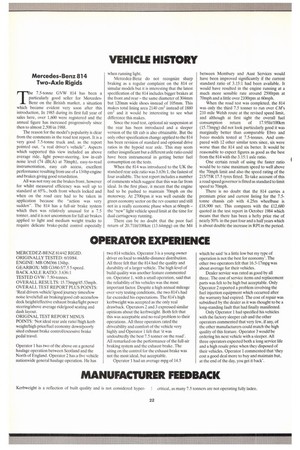VEHICLE HISTORY
Page 138

If you've noticed an error in this article please click here to report it so we can fix it.
Mercedes-Benz 814 Two-Axle Rigids The 7.5-tonne GVW 814 has been a particularly good seller for MercedesBenz on the British market, a situation which became evident very soon after this introduction, In 1985 during its first full year of sales here, over 1,600 were registered and the annual figure has increased progressively since then to almost 2,500 in 1988.
The reason for the model's popularity is clear from the comments in the road test report. It is a very good 7.5-tonne truck and, as the report pointed out, "a real driver's vehicle". Aspects which supported this view included an above average ride, light power-steering, low in-cab noise level (74 dB(A) at 70mph), easy-to-read instrumentation, easy cab access, excellent performance resulting from use of a 134hp engine and brakes giving good retardation.
All was not rosy on the brakes front, however for whilst measured efficiency was well up to standard at 65%, both front wheels locked and when on the road care had to be taken in application because the "action was very sudden". The 814 has a full-air brake system which then was relatively unusual for a 7.5 tonner. and it is not uncommon for full air brakes applied to light and medium weight trucks to require delicate brake-pedal control especially when running light.
Mcrcedez-Benz do not recognize sharp braking as a regular complaint on the 814 or simular models but it is interesting that the latest specification of the 814 includes bigger brakes at the front and rear the same diameter of 304mm but 120mm wide shoes instead of 105mm. This makes total lining area 2140 cm2 instead of 1880 cm2 and it would be interesting to see what difference this makes.
Since the road test, optional air suspension at the rear has been introduced and a sleeper version of the tilt cab is also obtainable. But the only other specification change applied to the 814 has been revision of standard and optional drive ratios in the hypoid rear axle. This may seem rather insignificant but a different axle ratio could have been instrumental in getting better fuel consumption on the tests.
When the 814 was introduced to the UK the standard rear axle ratio was 3.636:1. the fastest of four available. The test report includes a number of comments which suggest that this was far from ideal. ln the first place, it meant that the engine had to be pushed to maintain 70mph on the motorway. At 2700rpm it was well outside the green economy sector on the rev counter and still not in a really economic phase when at 60mph the "newlight vehicle speed limit at the time for dual carriageway running.
There can be no doubt that the poor fuel return of 20.711it/100km (13.64mpg) on the M4 between Membury and Aust Services would have been improved significantly if the current standard ratio of 3.15:1 had been available. It would have resulted in the engine running at a much more sensible rate around 2500rpm at 70mph and a little over 2100rpm at 60mph.
When the road test was completed, the 814 was only the third 7.5 tonner to run over CM's 210 mile Welsh route at the revised speed limit, and although at first sight the overall fuel consumption return of 17.951i t/100km (15.73mpg) did not look particularly good it was marginally better than comparable Ebro and Iveco models tested at 7.5-tonnes. And compared with 12 other similar tests since, six were worse than the 814 and six better. It would be reasonable to expect figures as good as the best from the 814 with the 3.15:1 axle ratio.
One certain result of using the faster ratio would be to raise maximum speed to well above the 70mph limit and also the speed rating of the 215/75R 17.5 tyres fitted. To take account of this a road speed governor is fitted as standard to limit speed to 70mph.
There is no doubt that the 814 carries a premium price and current listing for the 7.5tonne chassis cab with 4.25m wheelbase is £18,900 net. This compares with the £12,680 quoted in the test report in October 1984 which means that there has been a hefty price rise of nearly 50% in the past four and a half years which is about double the increase in RP1 in the period.




























































































































































































